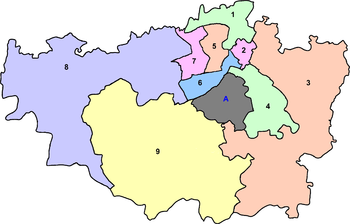Walled City of Lahore
Coordinates: 31°35′02″N 74°19′01″E / 31.584°N 74.317°E

↓North, →West
The Walled City of Lahore, also known as the "Old City", or "Androon Shehr" (Urdu: اندرون شہر), (Literal meaning 'Interior City') is the section of Lahore, Punjab, in Pakistan, that was fortified by a city wall during the Mughal era. It is located in the northwestern part of the city.
Origins
.jpg)

The origins of the original Lahore are unspecific. According to carbon dating evidence of archaeological findings in the Lahore Fort, the time period may start as early as 2,000 BCE. Lahore had many names throughout its history. Mohallah Maulian represents one of the two most probable sites of the original Lahore. Sootar Mandi (the yarn market) inside Lahori Gate, had been called Mohallah Chaileywala Hammam located in Machli Hatta Gulzar, just off Chowk Chalka.
As late as 1864, the Lahori Mandi area had been known among the old folk of the Walled City as kacha kot, the mud fort, a name derived from the gradient of the land, the water flow, and the formation of mohallahs, kuchas, and kattrahs. The curve of Koocha Pir Bola merges with Waachowali Bazaar, the Lahori Bazaar merges with Chowk Lahori Mandi, and Chowk Mati merges with Papar Mandi, giving a sense of a mud fort. Along Lahori Bazaar, a short distance from Chowk Chakla, the street opens slightly, revealing a half-buried archway of pucca bricks and mud.
The mud fort may have been built by Malik Ayaz, the first Muslim governor of Lahore. Lahori Gate served as the main entrance to Ayaz's mud fort. Chowk Sootar Mandi constituted one important center of Kacha Kot. The lay of the streets also suggest the boundaries. At the time of Mughal Emperor Akbar, the original wall of the Walled City of Lahore stood, on the western side, to the right of Bazaar Hakeeman in Bhati Gate. On the eastern side to the left of Shahalam Gate, curved eastwards and formed a "kidney-shaped" city that depended on the flow of the curving River Ravi. Thus the Lahore of the kacha kot era has continued to expand in three major leaps of expansion, each with an almost 400-year gap. The eras of Raja Jaipal of Akbar and of Maharaja Ranjit Singh mark the high points of that expansion.
The expanding of the mud fort had its origins in three factors:
- the way the Ravi has flown and how and when it has been changing its course,
- the existence of the Lahore Fort and how power has flowed from the rulers, and
- the manner the population and economy of the old original Walled City has changed over time, grown, or even shrunk, depending of invasions, droughts and famines in the countryside.
The story of kacha kot has been determined by those factors. The oldest buildings in the entire Walled City exist in this area, among them the old exquisite mosque known even now as Masjid Kohana Hammam Chaileywala. A huge hammam may have stood during the kacha kot period. The tomb of Pir Bola (Gali) still exists. Little remains of the original mud fort.
Demographics
The Walled City of Lahore covers an area of 256 ha with a population of 200,000. The city walls were destroyed shortly after the British annexed the Punjab in 1849 and were replaced with gardens, some of which exist today. The Circular Road links the old city to the urban network. Access to the Walled City is still gained through the 13 ancient gates, or their emplacements.
The convoluted and picturesque streets of the inner city remain almost intact, but the rapid demolition and frequently illegal rebuilding taking place throughout the city is causing the historic fabric to be eroded and replaced by inferior constructions. Historic buildings are no exception, and some have been encroached upon. The few old houses in the city are usually two or three stories tall, with brick façades, flat roofs, richly carved wooden balconies and overhanging windows.
Gates of Lahore
Walled City of Lahore had 13 gates: Akbari Gate, Bhati Gate, Delhi Gate, Kashmiri Gate, Lahori Gate, Masti Gate, Mochi Gate, Mori Gate, Roshnai Gate, Shahalmi Gate, Shairanwala Gate, Taxali Gate, and Yakki Gate. All of these gates survived until the 19th century. In an effort to defortify the city, the British demolished almost all of the gates except Roshnai Gate. This was done in the aftermath of 1857 Uprising, after the Siege of Delhi, during which the same treatment was meted to the Walled City of Delhi, the Mughal Capital (5 of the 13 Gates of Old Delhi survive today, while the rest including Lahori Gate (not the Lahori Gate of Red Fort) were demolished by the British). Some were rebuilt in simple structures, except for Delhi Gate and Lahori Gate. Shahalmi Gate burnt to ground during the riots of 1947 while Akbari Gate was demolished for repairs but never built again. Today, out of 13, only Bhati Gate, Delhi Gate, Kashmiri Gate, Lahori Gate, Roshnai Gate, and Shairanwala Gate survive, yet many are in urgent need of repairs and restoration.
Surviving gates
| Name | Picture | Description |
|---|---|---|
| Bhati Gate |  |
The entrance to the "Bhati Gate" is located on the western wall of the old city. The area inside the gate is well known throughout the city for its food. Just outside "Bhati Gate" is the Data Durbar, the mausoleum of the Sufi saint Ali Hajweri (also known as Data Sahib Ganjbaksh). Every Thursday evening Na`at reciters and Qawawals (who perform Qawwali) gather here to recite Na`at and perform religious Qawwali. |
| Delhi Gate |  |
The "Dehli Gate" was once the main and only road that led from Lahore to Delhi. The gate was built during the Mughal era. Although the gate suffered greatly in the 1947 riots, it has since been renovated and today is in its former glory. |
| Kashmiri Gate | 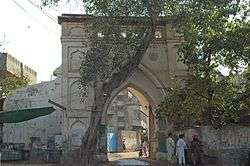 |
The "Kashmiri Gate" is so named because it faces the direction of Kashmir. Inside the gate, there is a shopping area called "Kashmiri Bazaar" and a girls' college. This college, built upon an old haveli belonging to a shah, is a beautiful example of Mughal architecture. |
| Lahori Gate | 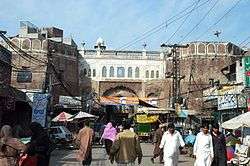 |
The "Lahori Gate" is very close to "Bhati Gate". Like many other gates, it was built to keep enemies out. Although it is now surrounded by shops and stalls, it still has great architectural significance. In Urdu, loha means "iron", and the gate is named Lahori because many lohars (blacksmiths) workshops were based just outside this gate. |
| Roshnai Gate | The "Roshnai Gate", also known as the "Gate of Lights", is located between the Lahore Fort and the Badshahi Mosque. As the gate was one of the main entrances into the city, it was constantly visited by Omerahs, courtiers, royal servants and retinues. In the evenings, the gate was lit up, hence its name. The gate was also referred to as the "Gate of Splendour". It is the only gate that is in good condition and still retains its original looks. | |
| Shairanwala Gate | 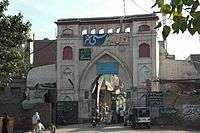 |
The "Shairanwala Gate", also known as the "Gate of the Lions", was made by Maharaja Ranjit Singh. After its completion, Singh placed two live lions (or Shers) in cages at the gate as a symbolic gesture to warn any invader. |
Gates that no longer exist
| Name | Description |
|---|---|
| Akbari Gate | The "Akbari gate", the most beautiful gate of lahore. The "Akbari Gate" is named after the great Mughal emperor Akbar, who rebuilt the town and citadel. Close to this gate the Emperor also founded a market, which is named after him, "Akbari Mandi". (Akbari Market) |
| Masti Gate | Just behind the Lahore Fort is the entrance to the "Masti Gate", also known as the "Gate of Merriment". This area is dominated by wholesale shoe sellers who sell both traditional- and Western-style shoes. Located further down the street is one of the city's oldest Masjids, the Masjid of Mariyam Zamani Begum, named after the mother of Jahangir, Mariyam Zamani. |
| Mochi Gate | Located at the entrance to Mochi Bagh (garden) and amidst a bustling bazaar (market), the "Mochi Gate" is a historical gate built during the Mughal period. In Urdu, Mochi means cobbler, which may indicate that the bazaar was once a market for shoes and repair shops. Another theory is that according to legend the gate was named after Moti, a guard of the gate during the Mughal era, who guarded and looked after the gate all his life. Later on, the name was distorted and became Mochi. Today, the bazaar around the Mochi gate is renowned for its dry fruits, kites and fireworks. Mochi Gate is the entrance to the Mochi Bagh, where many renowned Pakistani leaders of past and present have delivered speeches. |
| Mori Gate | Located between the Lahori Gate and Bhati Gate, the "Mori Gate" is the smallest of the gates of the walled city. This gate was used to remove the waste and disposal material from the city. Mori Gate was never considered an official gate, but the residents of Lahore considered it to be the 13th gate. |
| Shah-Alami Gate | The "Shah-Alami Gate" is named after one of the sons of the Mughal emperor Aurangzeb, Shah Alam I. Before his death, the gate was called the "Bherwala Gate". During the 1947 independence riots, the gate was burned. Today only the name survives. One of Lahore's biggest commercial markets, "Shah Alam Market" or Shalmi as locals call it, exists near the site of the gate. |
| Taxali Gate | The "Taxali Gate", also known as the Taxal (royal mint), was built during the Mughal reign. There is a shoe market located here known as Sheikupurian Bazar. There are a variety of foods available in and around this gate - one of the most beloved being Sri Pai from Fazal Din aka "Phajja". Taj Mehal and Shahbudin Halwi are a couple of the more popular sweet stores. |
| Yakki Gate | The "Yakki Gate" was named after the martyr saint "Zakki". Zakki fell while defending the city against the Mughal invaders from the north. Over time the name "Zakki" became distorted to what the gate is known as today: "Yakki". |
Sites of interest
Lahore Fort

The Lahore Fort, locally referred to as Shahi Qila citadel of the city of Lahore, Punjab, Pakistan. It is located in the northwestern corner of Lahore, adjacent to the Walled City. Sites within the fort include Sheesh Mahal, Alamgiri Gate, Naulakha pavilion, and Moti Masjid. The fort is 1,400 feet long and 1,115 feet wide. In 1981, the fort was inscribed as a UNESCO World Heritage Site along with the Shalamar Gardens.
Historic mosques
Badshahi Masjid
.jpg)
The Badshahi Masjid (Urdu: بادشاھی مسجد), or the Emperor's Masjid, was built in 1673 by the Mughal Emperor Aurangzeb in Lahore, Pakistan. It is one of the city's best known landmarks, and a major tourist attraction epitomizing the beauty and grandeur of the Mughal era.
Capable of accommodating over 55,000 worshipers, it is the second largest Masjid in Pakistan, after the Faisal Masjid in Islamabad. The architecture and design of the Badshahi Masjid is closely related to the Jama Masjid in Delhi, India, which was built in 1648 by Aurangzeb's father and predecessor, emperor Shah Jahan.
Wazir Khan Mosque
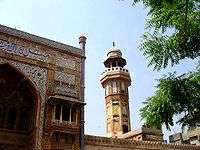
The Wazir Khan Mosque in Lahore, Pakistan, is known for its extensive faience tile work. It has been described as "a mole on the cheek of Lahore". It was built in seven years, starting around 1634-1635 AD, during the reign of the Mughal Emperor Shah Jehan. It was built by Shaikh Ilm-ud-din Ansari, a native of Chiniot, who rose to be the court physician to Shah Jahan and later, the Governor of Lahore. He was commonly known as Wazir Khan (the word wazir means "minister" in Urdu language). The Masjid is located inside the Inner City and is easiest accessed from Delhi Gate.
Data Durbar Complex
Data Durbar is the tomb of Hazrat Syed Abul Hassan Bin Usman Bin Ali Al-Hajweri, the Sufi saint of South Asia, where hundreds of thousands of people come each year to pay their respects and to say their prayers. It is located in Lahore, Punjab, Pakistan. The large complex also includes Jamia Hajveria, or Hajveri Masjid.
Others
Other well known Masjids inside the Walled City are Suneri Mosque, the Masjid of Mariyam Zamani, Doongi Masjid and the tomb of Maharaja Ranjit Singh of the Sikh Empire.
Havelis
There are many havelis inside the Walled City of Lahore, some in good condition while others need urgent attention. Many of these havlis are fine examples of Mughal and Sikh Architecture. Some of the havelis inside the Walled City include:
- Mubarak Begum Haveli Bhatti Gate
- Chuna Mandi Havelis
- Haveli of Nau Nihal Singh
- Nisar Haveli
- Haveli Barood Khana
- Salman Sirhindi ki Haveli
- Dina Nath Ki Haveli
- Mubarak Haveli - Chowk Nawab Sahib, Mochi/Akbari Gate
Other landmarks
- Shahi Hamam
- Samadhi of Ranjit Singh
- Tomb of Malik Ayaz
- Lal Haveli beside Mochi Bagh
- Mughal Haveli (Residence of Maharaja Ranjeet Singh)
- Haveli Sir Wajid Ali Shah (Near Nisar Haveli)
- Haveli Mian Khan (Rang Mehal)
- Haveli Shergharian (Near Lal Khou)
Historic neighborhoods surrounding old city
- Anarkali
- Shahdara Bagh
- Mughalpura
- Begumpura
- Baghbanpura
- Badami Bagh
Restorations and conservation projects
- The Punjab government in cooperation with Aga Khan Trust for Culture (AKTC) is working on restoring the Royal Trail (Shahi Guzar Gah) from Akbari Gate to the Lahore Fort with the help of World Bank under the Sustainable Development of the Walled City of Lahore (SDWCL) project. The project aims at the Walled City development, at exploring and highlighting economic potential of the Walled City as a cultural heritage, exploring and highlighting the benefits of the SWDCL project for the residents, and at soliciting suggestions regarding maintenance of development and conservation of the Walled City.
See also
- Lahore
- Lahore Fort
- Badshahi Mosque
- Suneri Mosque
- Wazir Khan Mosque
- Fakir Khana
- Fort Road, Lahore
- Fort Road Food Street, a food street in the walled city serving Lahori food
- Shaheed Ganj Mosque
- Naulakha Bazaar
- lunda Bazar
External links
- The Official Website of "Sustainable Development of Walled City Lahore Project"
- Lahore Photos and History
- Walled City Has thirteen gates
- Tour of the Walled City
- Information about the gates & history
- Travel: Information about the Fort
- Attractions of Lahore
- Places to See: The gates of Lahore
- Aerial Map of Lahore on WikiMapia.org
- Thirteen Gates of Lahore
